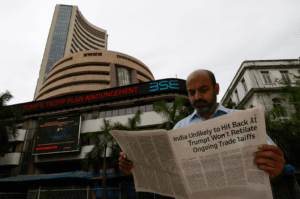India’s Smart Move: 5 Powerful Reasons It Won’t Retaliate Against Trump’s Tariffs
India has decided not to retaliate against U.S. President Donald Trump’s 26% import tariffs, as trade talks between the two nations continue. Government officials say that India is exploring a clause in the tariff order that offers relief to countries willing to address trade imbalances. By choosing diplomacy over confrontation, India aims to strengthen its negotiating position, especially compared to other Asian economies like China and Vietnam that face steeper tariffs. The two nations are working toward a preliminary trade deal expected by autumn 2025.
India is also considering lowering tariffs on $23 billion worth of U.S. goods and has already made goodwill gestures, such as reducing duties on luxury bikes and bourbon, and scrapping a digital tax impacting American tech companies. These steps are part of India’s strategy to build closer trade ties with the U.S. However, economists warn the new tariffs could shave 20–40 basis points off India’s GDP and severely affect the diamond export industry, which heavily relies on the U.S. market. Despite potential short-term pain, India appears committed to a long-term, deal-driven approach.

India’s Smart Move: 5 Powerful Reasons It Won’t Retaliate Against Trump’s Tariffs
India has opted not to respond with counter-tariffs to President Donald Trump’s recent decision to impose a 26% tariff on imports from the country. According to officials close to the matter, New Delhi is prioritizing ongoing trade talks with the United States, taking a diplomatic approach rather than retaliating immediately.
A senior government source, who asked not to be named due to the confidential nature of the discussions, revealed that India is examining a section of Trump’s tariff order that leaves room for exemptions. This clause could benefit countries willing to take meaningful action to resolve what the U.S. considers unfair trade practices. India sees this as a potential opportunity to secure relief by showing a commitment to resolving trade imbalances.
Another official mentioned that India is in a more favorable position than some of its neighboring countries in Asia. While nations such as China, Vietnam, and Indonesia have been hit hard by U.S. trade measures, India was quicker to initiate conversations with American officials. This early engagement could give India a valuable edge in negotiations and help it avoid the worst effects of the new tariffs.
Trump’s tariff announcement shook global financial markets, sparking fears of a broader trade war. While some countries are preparing retaliatory measures, India has joined others like Taiwan and Indonesia in holding back. Meanwhile, the European Union is gearing up to impose its own counter-tariffs in response to U.S. actions, and China has already taken similar steps.
India and the United States had already agreed in February to aim for an initial trade agreement by fall 2025. This deal is expected to help both sides address several sticking points that have caused tension in recent years. Although Prime Minister Narendra Modi’s office hasn’t made an official statement on the situation, the government’s actions so far suggest a preference for keeping the dialogue with Washington open and productive.
In an effort to demonstrate goodwill and move closer to a deal, India has taken several steps to address U.S. concerns. According to a recent Reuters report, India is open to reducing tariffs on around $23 billion worth of American goods. The Modi government has already lowered import duties on premium motorcycles, including U.S.-made brands like Harley-Davidson, and has also reduced taxes on bourbon whiskey. Additionally, India withdrew its digital services tax, which had previously targeted major U.S. tech firms such as Google, Amazon, and Facebook.
Despite this cooperative approach, experts warn that the tariffs could still negatively impact India’s economy. Economists predict the new U.S. trade barriers could reduce India’s GDP growth by 20 to 40 basis points in the current financial year. One of the hardest-hit sectors could be the diamond industry, which relies heavily on exports to the United States. Over a third of India’s diamond exports go to the U.S., and the added tariffs could seriously hurt demand, threatening thousands of jobs in the process.
Even with these challenges, the Indian government is focused on the bigger picture. Instead of retaliating, it’s placing its bets on long-term trade stability through negotiation and cooperation. Officials believe that avoiding an immediate trade battle could help India build a more balanced and beneficial relationship with the U.S. in the future.
This careful and calculated response shows a shift in India’s approach to international trade disputes. Rather than reacting emotionally or hastily, the Modi administration is relying on strategic diplomacy to navigate complex global economic dynamics and protect India’s long-term interests.
You must be logged in to post a comment.